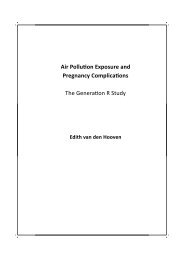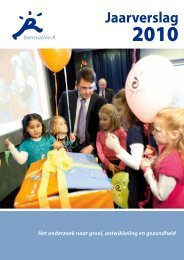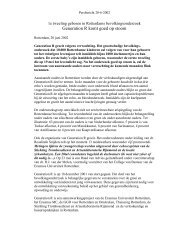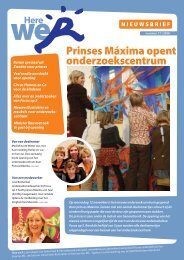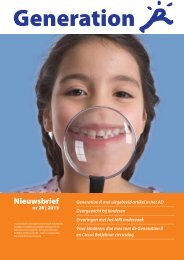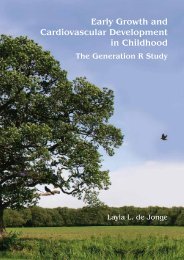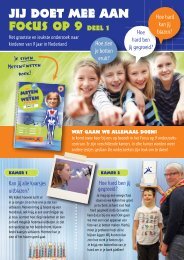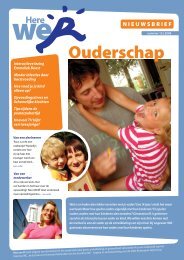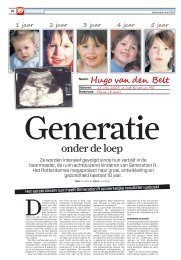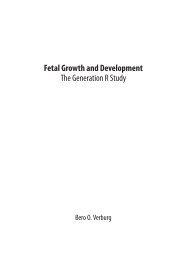Parents and infants: determinants of attachment in a ... - Generation R
Parents and infants: determinants of attachment in a ... - Generation R
Parents and infants: determinants of attachment in a ... - Generation R
You also want an ePaper? Increase the reach of your titles
YUMPU automatically turns print PDFs into web optimized ePapers that Google loves.
Attachment, depression, <strong>and</strong> cortisol: Deviant patterns <strong>in</strong> <strong>in</strong>secure-resistant <strong>and</strong> disorganized <strong><strong>in</strong>fants</strong><br />
Observations <strong>of</strong> <strong>in</strong>fant behavior <strong>in</strong> the SSP allow for classification <strong>of</strong> <strong>in</strong>fant<br />
behavior patterns <strong>in</strong>to secure, <strong>in</strong>secure-avoidant, <strong>and</strong> <strong>in</strong>secure-resistant<br />
strategies. A secure (B) child seeks contact with the parent upon reunion,<br />
either physically or by distance <strong>in</strong>teraction, to be comforted or reassured<br />
after the separation <strong>and</strong> resume exploration <strong>of</strong> the environment when he/<br />
she is settled. Insecure-avoidant (A) children, on the other h<strong>and</strong>, focus on<br />
the environment at the moment <strong>of</strong> reunion, ignor<strong>in</strong>g the parent or even<br />
turn<strong>in</strong>g away from the parent. The reunion behavior <strong>of</strong> an <strong>in</strong>secure-resistant<br />
(C) child is characterized by anxious contact seek<strong>in</strong>g <strong>and</strong> cl<strong>in</strong>g<strong>in</strong>g <strong>and</strong><br />
at the same time resist<strong>in</strong>g contact with the parent. Resistant children are<br />
usually clearly distressed <strong>and</strong> their <strong>in</strong>teraction with the parent may have an<br />
angry quality. On top <strong>of</strong> these classifications, the level <strong>of</strong> disorganization can<br />
be determ<strong>in</strong>ed. Disorganized (D) children show a temporary breakdown <strong>of</strong><br />
their secure, avoidant or resistant strategy <strong>of</strong> deal<strong>in</strong>g with the return <strong>of</strong> the<br />
parent after separation, for example by simultaneous display <strong>of</strong> contradictory<br />
behaviors such as distress <strong>and</strong> avoidance (Ma<strong>in</strong> & Solomon, 1990).<br />
Cortisol is released as a result <strong>of</strong> many aspects <strong>of</strong> an organism’s <strong>in</strong>teraction<br />
with the environment, <strong>in</strong>clud<strong>in</strong>g response to novelty <strong>and</strong> psychological<br />
stressors (Gunnar, 1994; Kirschbaum & Hellhammer, 1989, 1994). In normal<br />
situations, production <strong>of</strong> cortisol follows a diurnal rhythm with high levels<br />
at awaken<strong>in</strong>g, an <strong>in</strong>crease <strong>in</strong> secretion shortly after awaken<strong>in</strong>g, followed by<br />
a decl<strong>in</strong>e throughout the day (Kirschbaum & Hellhammer, 1989; Watamura,<br />
Donzella, Kertes, & Gunnar, 2004). This diurnal rhythm <strong>in</strong> basal cortisol<br />
levels is relatively stable <strong>in</strong> adults, but early <strong>in</strong> life the Hypothalamic-<br />
Pituitary-Adrenal (HPA) system shows <strong>in</strong>stability, <strong>and</strong> it cont<strong>in</strong>ues to<br />
mature throughout <strong>in</strong>fancy <strong>and</strong> childhood (De Weerth & Van Geert, 2002;<br />
De Weerth, Zijl, & Buitelaar, 2003; Watamura et al., 2004).<br />
In stressful conditions, cortisol levels may rise. The cortisol response<br />
to stress serves an important function <strong>in</strong> adaptation to novel or stressful<br />
circumstances (Gunnar & Donzella, 2002; Van Bakel & Riksen-Walraven,<br />
2004). Various studies have tested the effect <strong>of</strong> stressful events on HPA-axis<br />
function<strong>in</strong>g <strong>in</strong> <strong><strong>in</strong>fants</strong>, most <strong>of</strong> them focus<strong>in</strong>g on cortisol levels around the<br />
SSP as related to <strong>in</strong>fant <strong>attachment</strong> classification. Several non-cl<strong>in</strong>ical studies<br />
on physiological reactions to the SSP documented children’s tendency<br />
to show elevated cortisol levels after the procedure. The most consistent<br />
f<strong>in</strong>d<strong>in</strong>g is that no or only little adrenocortical activation is observed <strong>in</strong><br />
securely attached <strong><strong>in</strong>fants</strong> (Gunnar, Brodersen, Nachmias, Buss, & Rigatuso,<br />
1996; Spangler & Grossmann, 1993). Several studies reported <strong>in</strong>creases <strong>in</strong><br />
cortisol levels for the disorganized <strong><strong>in</strong>fants</strong> (Hertsgaard et al., 1995; Spangler<br />
& Grossmann, 1993; Spangler & Schieche, 1998).<br />
<br />
87



